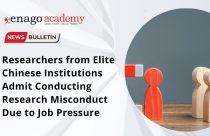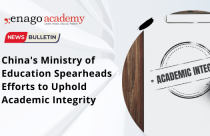How Will the New Chinese STM Policy Reduce Publishing Burden on Researchers?

China is quickly becoming a scientific research powerhouse. Chinese research, and researchers, are more prominent worldwide than ever before. One reason for this is that Chinese researchers are publishing more papers every year. According to a recent study, China produces 13.8% of all published articles. Although this is still some way behind the USA – the world’s largest producer of scientific articles, at 25.4% – the number of articles published by Chinese researchers is increasing every year.
The Publishing Burden
As in other parts of the world, Chinese researchers have been relying on publications to advance their careers. Job opportunities, research funding and recognition have all been based on a researcher’s publication history. Citations often measure the success of an author. More publications mean more citations.
As a result, many researchers experience “pressure to publish.” This can lead to scientific misconduct. For example, researchers might engage in citation manipulation. This is when an author’s citations are artificially boosted, through self-citation, for example. Senior researchers may be co-authors on papers they have had little or no involvement with. Scientific misconduct like this can damage the reputation of the whole scientific community.
China’s New STM Policy
Recently, China announced a new STM policy that could help to reduce both “pressure to publish” and scientific misconduct. Let’s take a look at that new policy.
Firstly – and perhaps most importantly – Chinese institutions have been banned from paying researchers bonuses for publishing in journals. These bonuses might encourage scientists to share the results of their work. However, in reality, they push researchers to publish large numbers of papers, rather than high-quality work. Ending bonuses should return the focus to quality, not quantity.
Another key point of the new policy is that institutions must not recruit or promote researchers solely on the basis of their publication record. This includes both publications and citations.
Until now, researchers applying for government grants have been assessed on their publication history. This had included the number of papers published, papers in journals listed in the Science Citation Index, and publishing in journals with high impact factors. As a result, institutions put their effort into meeting these criteria. One way they did this was by putting pressure on researchers to publish as many papers as possible.
The new policy says that the publication history will only evaluate basic science and technology researchers. In this method, known as “representative works system”, only a limited number of a researcher’s most important publications will count. Out of the relevant publications, at least one third of the papers must be published in Chinese journals. Number of papers and journal impact factors will no longer be used to measure performance.
Highlights of the New Chinese STM policy
According to the new policy, researchers should aim to publish in:
- Domestic STM journals with international influence
- Top international journals universally recognized in the research field
- Top domestic and international academic conferences
Individual researchers will be limited to submitting just five representative works in grant applications.
One of the major key highlights of this new policy is that researchers in applied science and technology will not be assessed on their publication history. This removes a great burden on these researchers. Previously these same researchers had to publish without doing relevant work in academia.
Other aspects of the new policy include:
- Developing high quality domestic journals, according to a newly developed Chinese citation index. Publicly-funded research will be published in domestic journals.
- Monitoring journal quality, for both domestic and international journals and blacklisting according to the reputation.
- Limiting publishing costs. There will be a special government fund for publishing representative works. If the cost for a single paper is excessive, publication will have to be approved by a committee. Universities will have to check the need to publish any paper.
Possible Impact of the Policy
Some researchers have welcomed the new policy, while others are more cautious. However, the reactions may vary according to the future enforcement of the new rules.
Here are some possible outcomes of the new policy:
- A decrease in the number of papers Chinese researchers submit to English-language journals, due to the new focus on quality of papers, and not quantity. Chinese researchers will also be encouraged to publish in domestic journals.
- Low-quality journals will see the biggest drop in submissions from China.
- Authors will have to consider publication costs when choosing which journal to target. This might be a problem for fully open access journals, which need to charge more. Researchers could target subscription or hybrid journals instead.
- Speciality journals, which tend to have lower impact factors, will have more chance to attract the best papers.
- Journals and conferences will need to ensure good practices so that they don’t end up on the blacklist.
What Does the Academic Community Think?
Among researchers, reaction to the new policy has been mostly positive. Reducing the pressure to publish should help researchers to focus more on producing high-quality work. A few worried researchers do not think there are enough Chinese-language journals to fulfil the one-third publishing requirement. Others believe that, in fact, competition to publish in the top international journals will become more fierce. Some Chinese researchers are concerned that publishing their best work in Chinese-language journals will lessen the impact of that work.
Among publishers, the reaction to the new policy is more negative. Many Chinese journals will not fall under this new publishing funding rule, and might struggle to survive.
In my view, the change of focus to quality over quantity is good for both individual researchers and for the reputation of the scientific community. After all, the primary job of scientists should be to conduct research, not to publish papers. However, it is important that Chinese researchers do not lose out on chances to publish internationally. International publications can also open up opportunities for international collaborations, to the benefit of all. New policies should try to balance these needs. One way to address these problems might be to build the profile of Chinese journals that publish in English.
What do you think about China’s new STM policy? Please share your thoughts in the comments section below.









